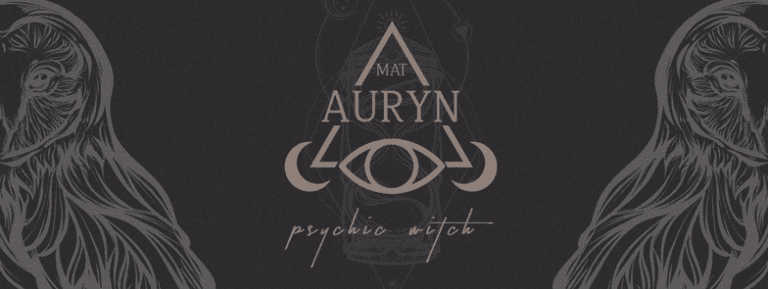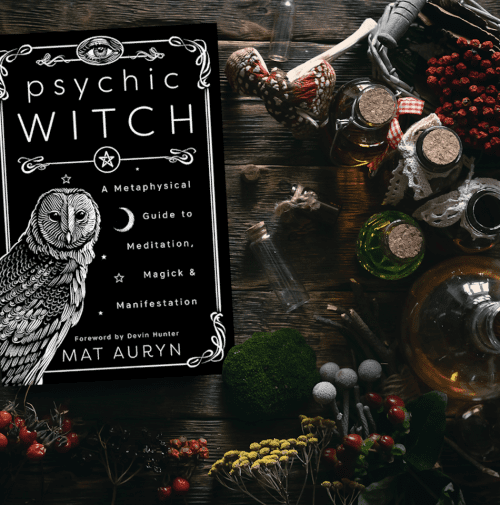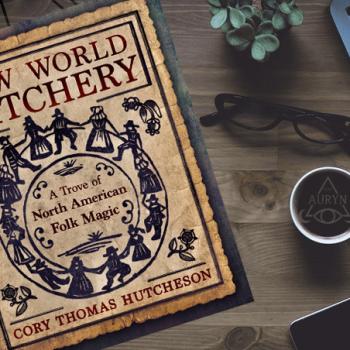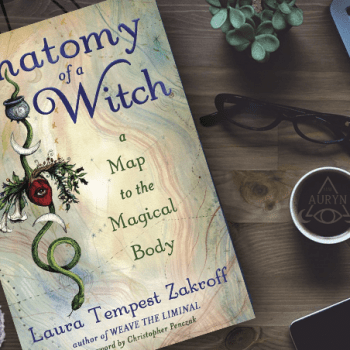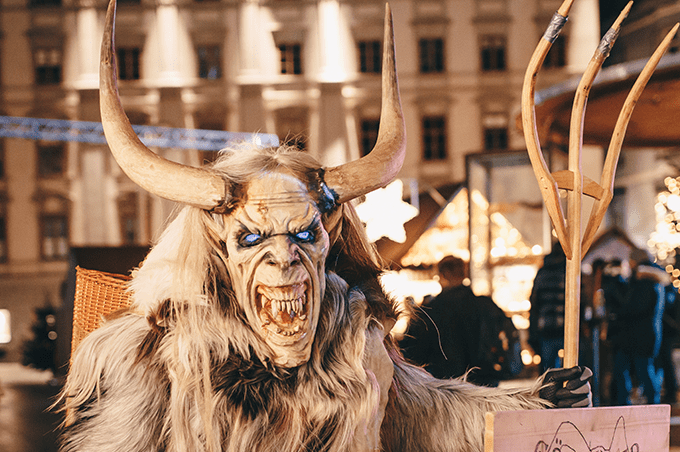
Deriving his name from the word “krampen” meaning “claw,” the Krampus is described as half-goat, half-demon; a satyr-like spirit who travels with Saint Nicholas and divines whether children have been naughty or nice. If naughty, one would be lucky merely to receive a beating from the Krampus with his birch twigs or to have one’s pigtails ripped out. In worst-case scenarios, he would lead children off a cliff in Pied Piper fashion, throw them in frozen lakes, drown them in his own bathtub, stab and eat them with a pitchfork, or capture them in his sack to be carried off directly to the Underworld.
The Krampus is believed to be the remnant of pre-Christian Alpine traditions of heathenry and paganism, originating Austria, Germany, and the Czech Republic. However, there’s very little hard evidence left that we can trace to prove this notion. Despite this, Maurice Bruce wrote in The Journal of Folklore 1958 that “there seems to be little doubt as to his true identity for, in no other form is the full regalia of the Horned God of the Witches so well preserved. The birch – apart from its phallic significance – may have a connection with the initiation rites of certain witch-covens; rites which entailed binding and scourging as a form of mock-death. The chains could have been introduced in a Christian attempt to ‘bind the Devil’ but again they could be a remnant of pagan initiation rites.”1
Some believe that the Krampus was originally a spirit of purification and warding, as scourging is usually seen as a ritual act of purification. He is also related to other traditions associated with this time of year, such as the Perchten. The Perchten were the entourage spirits of Frau Perchta, a goddess sometimes associated with Holda and Frigga. Jacob Grimm, a collector of folktales and the editor of the famous Grimm’s Fairy Tales stated that Frau Perchta, as the guardian of beasts, was responsible for the Krampus. The Perchta were divided into two groups; the Schönperchten, who were the beautiful and kind spirits, and the Schiachperchten, the ugly and wild spirits in her retinue. The Schiachperchten are depicted as hairy and horned satyr-monsters, and much like the Krampus, they went door-to-door to drive away evil spirits, ghosts, and demons.
We see a similar tradition with the Krampus. On December 5th, known as Krampusnacht (or “Krampus night”), young men donned masks, goat horns, and animal fur costumes to represent the Krampus and travelled door-to-door, demanding libations of alcohol (customarily Schnapps liquor). As these men became drunker and drunker (perhaps possessed by the spirit of the Krampus they were emulating), they began accusing the people they met of their misdeeds and sins and threatening to beat them as punishment. Here we even see a hint of the archetype of Satan as the divine accuser, contrasted by Saint Nicholas as a holy benefactor.
This drunken procession called the Krampuslauf (meaning “Krampus run”), would soon turn into chaos and riots—and the men dressed as Krampus would turn from chasing children to chasing women as they grew increasingly more intoxicated. We see recurring themes here, which echo those of the Yule Goat, a similar spirit who was once the focus of fertility rites during the winter. The Yule Goat, believed to be of Proto-Indo-European origin, would have women sit upon his lap during his procession from house to house. (This may even be the origin of sitting on Santa’s lap.) The Krampus’ sexuality, like that of nearly every other horned pagan deity, hasn’t died either. The tradition of Krampuskarten (or “Krampus cards”) —comparable to the greeting cards exchanged for Christmas or Yule—evolved from illustrating the Krampus abducting or punishing children, to depicting very sadomasochistic, sexually themed cards where he’s pursuing and spanking women (or vice versa).
The Krampus is a persistent spirit who can’t seem to be erased by either religion or government. He was denounced by the Church and by fascist rule in Austria in 1934 and 1938. He’s been called a symbol of anti-Christianity, sinfulness, wickedness, and even social democracy. The Krampus has been repeatedly boycotted and denounced by child psychologists since 1953 for being psychologically scarring. Despite all the attempts to suppress this winter spirit, he remains more popular than ever right now, making appearances in pop culture through the media of movies, books, and television shows. Sometimes you just can’t keep a wild demon bound. Even when shown chained and restrained (a motif, it should be noted, that was added to his depiction by the Church), the Krampus continues to roam wild and free.
1. Bruce, Maurice (March 1958). “The Krampus in Styria”. Folklore. 69 (1): 44–47↩
View this post on Instagram
This article of mine was originally published in the Winter Solstice 2017 issue of Horns Magazine and reproduced here with permission.
Related Articles:
Mat Auryn – This Fashionista Cat Devours People To Celebrate Yule
Mat Auryn – The Child-Eating Scarecrow Of Christmas
Mat Auryn -The Mischievous Tomte Spirits of Yule
Mat Auryn – A Brief History of The Krampus
Mat Auryn – What Is The Winter Solstice?
Mat Auryn – Seasonal Depression & The Winter Solstice
Connect With Me:
Click Below To Purchase My Book:

